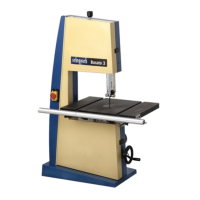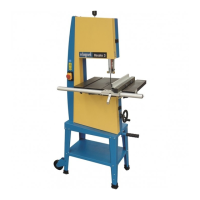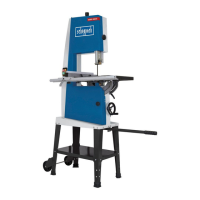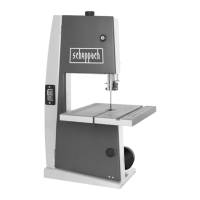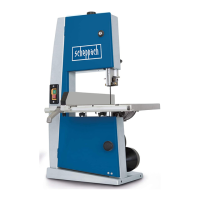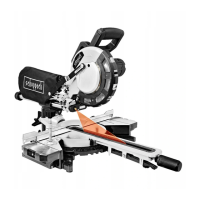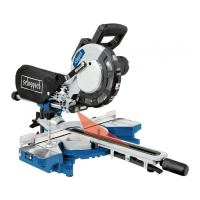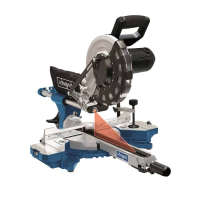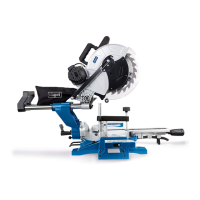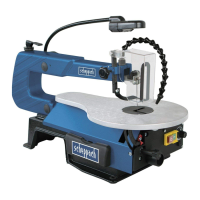• Loosen the saw blade by unscrewing tighteningscrew
B.
• Fitthenewsawblade.
• Turnthebandwheelbyhandinthecuttingdirection,
whileat the same timeusinghandle B totighten the
blade. The tightness depends on the width of the saw
blade. Wider saw blades have to be tighter than narrow
ones.
Attention: Overtightening the blade will lead to premature
breaking of the blade!
After you have finished working with the band saw, the saw
blade should always be loosened! Do so by moving lever
Ato„–“.
Side-to-side corrections, Fig. 8
•Thesawbladeshouldrunmoreorlessinthemiddleof
the wheel belts.
•Turntheupperwheelbeltmanuallyinthecuttingdirec-
tion,andmakeside-to-sidecorrectionsbythegrip(1).
•Aftersuccessfuladjustment,tightenthewing-bolts(2)
The upper saw blade leader can be adjusted by up to 250
mm of the height of the work piece(3).Keepingthedistance
to the work piece as small as possible allows the optimal
leading of the blades and a secure working situation!
Adjustment of rotational speed, Fig. 9
Warning: Unplug the machine!
•Openthesawblade,protectionunitandsecureitwith
a block.
• Release grip A on the motor side; release the belts.
Change the belts if necessary.
•Now,adjustthedesiredrotationalspeed:
Step1=1200m/min.
Step2=800m/min.
•TightenthebeltsandgripAonceagain.Thenclosethe
saw blade, protection unit.
Counter pressure bearing, Fig. 10
Thecounterpressurebearing(1)assumesthefeedpres-
sure from the work piece.
Adjust the upper and lower counter pressure bearings so
they lightly touch the saw blade backs.
Guide rollers, Fig. 10
Adjusttheupperandlowerguiderollers(2)tothebreadth
of each of the saw bands. The front corner of the guide roll-
ers should only reach to the highest tooth base of the saw
blade. If the guide rollers lightly touch the saw blade, re-
tract them with the knurled screw on the base of the rolls.
The saw bands must not jam!
m Working information
The following recommendations are examples of the safe
use of band saws.
The following safe working methods should be seen as an
aid to safety. They cannot be applied suitably completely
or comprehensively to every use. They cannot treat every
possible dangerous condition and must be interpreted
carefully.
• Connect the machine to a suction unit when working
in closed rooms. A suction device which conforms with
commercial regulations must be used for suction in
commercial areas.
• Loosenthesawbandwhenthemachineisnotinopera-
tion(e.g.afternishingwork).Attachanoticeonthe
tension of the saw band to the machine for the next
user.
• Collectunusedsawbandsandstorethemsafelyinadry
place.Checkforfaults(teeth,cracks)beforeuse.Donot
use faulty sawbands!
• Wearsuitablegloveswhenhandlingsawbands.
• All protective and safety devices must be securely
mounted on the machine before beginning work.
• Nevercleanthesawbandorthesawbandguidewitha
hand-held brush or scraper while the sawband is run-
ning.Resin-coveredsawbandsimpairworkingsafetyand
must be cleaned regularly.
• For your own protection, wear protective glasses and
hearing protection. Wear a hairnet if you have long hair.
Rolluploosesleevesovertheelbows.
• Always position the sawband guide as near the work-
piece as possible when working.
• Insuresufcientlightingintheworkareaandaroundthe
machine.
• Alwaysusethefenceforstraightcutstokeepthework-
piece from tipping or slipping away.
• Whenworkingonnarrowworkpieceswithmanualfeed,
use the push stick.
• Fordiagonalcuts,placethesawbenchintheappropri-
ate position and guide the workpiece on the fence.
• Insuresafeworkpieceguidance.
• Forarcedandirregularcuts,pushtheworkpieceevenly
using both hands with the fingers together. Hold the
workpiece with your hands on a safe area.
• Useapatternforrepeatedarcedorirregularcuts.
• Insure that the workpiece does not roll when cutting
round pieces.
• Use the traverse cutting gauge special accessory for
safety when making traverse cuts.
m Electrical Connection
The installed electric motor is connected and is ready to
work.
TheconnectioncomplieswiththerelevantVDEandDIN
regulations.
The customer-side mains supply and the used extension
line must meet these regulations.
Installations, repair, and maintenance work relating to the
electric installation may only be performed by specialists.
Important Notes
The electric motor has been designed for the S 1 operating
mode.
In case of an overload of the motor, it turns off automati-
cally.Afteracoolingperiod(durationvaries),youcanturn
on the motor again.
Defective Electric Connection Lines
Often, insulation damages occur on electrical connection
lines.
Causes are:
• Dragmarksifconnectionlinesareledthroughwindowor
door clearances.
• Kinksduetoimproperattachmentorroutingofthecon-
nection line.
• Cutscausedbyrunningovertheconnectionline.
• Insulation damages caused by pulling the connection
line out of the wall socket.
• Fissurescausedbytheageingoftheinsulation.
Such defective electric connection lines must not be used
and are hazardous due to the insulation damages.
